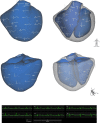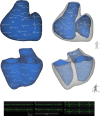Simultaneous Non-Invasive Epicardial and Endocardial Mapping in Patients With Brugada Syndrome: New Insights Into Arrhythmia Mechanisms
- PMID: 27930354
- PMCID: PMC5210320
- DOI: 10.1161/JAHA.116.004095
Simultaneous Non-Invasive Epicardial and Endocardial Mapping in Patients With Brugada Syndrome: New Insights Into Arrhythmia Mechanisms
Abstract
Background: The underlying mechanisms of Brugada syndrome (BrS) are not completely understood. Recent studies provided evidence that the electrophysiological substrate, leading to electrocardiogram abnormalities and/or ventricular arrhythmias, is located in the right ventricular outflow tract (RVOT). The purpose of this study was to examine abnormalities of epicardial and endocardial local unipolar electrograms by simultaneous noninvasive mapping in patients with BrS.
Methods and results: Local epicardial and endocardial unipolar electrograms were analyzed using a novel noninvasive epi- and endocardial electrophysiology system (NEEES) in 12 patients with BrS and 6 with right bundle branch block for comparison. Fifteen normal subjects composed the control group. Observed depolarization abnormalities included fragmented electrograms in the anatomical area of RVOT endocardially and epicardially, significantly prolonged activation time in the RVOT endocardium (65±20 vs 38±13 ms in controls; P=0.008), prolongation of the activation-recovery interval in the RVOT epicardium (281±34 vs 247±26 ms in controls; P=0.002). Repolarization abnormalities included a larger area of ST-segment elevation >2 mV and T-wave inversions. Negative voltage gradient (-2.5 to -6.0 mV) between epicardium and endocardium of the RVOT was observed in 8 of 12 BrS patients, not present in patients with right bundle branch block or in controls.
Conclusions: Abnormalities of epicardial and endocardial electrograms associated with depolarization and repolarization properties were found using NEEES exclusively in the RVOT of BrS patients. These findings support both, depolarization and repolarization abnormalities, being operative at the same time in patients with BrS.
Keywords: Brugada syndrome; ajmaline challenge; arrhythmia; depolarization; electrocardiography; endocardium; epicardium; repolarization; right bundle branch block; right ventricular outflow tract; sudden death.
© 2016 The Authors. Published on behalf of the American Heart Association, Inc., by Wiley Blackwell.
Figures



Similar articles
-
ST-Segment Elevation and Fractionated Electrograms in Brugada Syndrome Patients Arise From the Same Structurally Abnormal Subepicardial RVOT Area but Have a Different Mechanism.Circ Arrhythm Electrophysiol. 2015 Dec;8(6):1382-92. doi: 10.1161/CIRCEP.115.003366. Epub 2015 Oct 19. Circ Arrhythm Electrophysiol. 2015. PMID: 26480928
-
Right ventricular outflow tract high-density endocardial unipolar voltage mapping in patients with Brugada syndrome: evidence for electroanatomical abnormalities.Europace. 2018 Jun 1;20(FI1):f57-f63. doi: 10.1093/europace/eux079. Europace. 2018. PMID: 28472282
-
Novel CineECG Derived From Standard 12-Lead ECG Enables Right Ventricle Outflow Tract Localization of Electrical Substrate in Patients With Brugada Syndrome.Circ Arrhythm Electrophysiol. 2020 Sep;13(9):e008524. doi: 10.1161/CIRCEP.120.008524. Epub 2020 Jul 28. Circ Arrhythm Electrophysiol. 2020. PMID: 32755392
-
Right ventricular outflow tract endocardial unipolar substrate mapping: implications in risk stratification of Brugada syndrome.Rev Cardiovasc Med. 2022 Jan 25;23(2):44. doi: 10.31083/j.rcm2302044. Rev Cardiovasc Med. 2022. PMID: 35229535 Review.
-
Brugada syndrome: insights of ST elevation, arrhythmogenicity, and risk stratification from experimental observations.Heart Rhythm. 2009 Nov;6(11 Suppl):S34-43. doi: 10.1016/j.hrthm.2009.07.018. Epub 2009 Sep 1. Heart Rhythm. 2009. PMID: 19880072 Review.
Cited by
-
Inherited Cardiac Arrhythmia Syndromes: Focus on Molecular Mechanisms Underlying TRPM4 Channelopathies.Cardiovasc Ther. 2020 Dec 16;2020:6615038. doi: 10.1155/2020/6615038. eCollection 2020. Cardiovasc Ther. 2020. PMID: 33381229 Free PMC article. Review.
-
Asymptomatic Brugada syndrome: Navigating implantable cardioverter-defibrillator implantation dilemma.HeartRhythm Case Rep. 2024 Sep 16;10(12):941-945. doi: 10.1016/j.hrcr.2024.09.008. eCollection 2024 Dec. HeartRhythm Case Rep. 2024. PMID: 39897681 Free PMC article. No abstract available.
-
Noninvasive phase mapping of persistent atrial fibrillation in humans: Comparison with invasive catheter mapping.Ann Noninvasive Electrocardiol. 2018 Jul;23(4):e12527. doi: 10.1111/anec.12527. Epub 2017 Dec 22. Ann Noninvasive Electrocardiol. 2018. PMID: 29271538 Free PMC article.
-
Epicardial origin of cardiac arrhythmias: clinical evidences and pathophysiology.Cardiovasc Res. 2022 Jun 22;118(7):1693-1702. doi: 10.1093/cvr/cvab213. Cardiovasc Res. 2022. PMID: 34152392 Free PMC article. Review.
-
iPSC-Cardiomyocyte Models of Brugada Syndrome-Achievements, Challenges and Future Perspectives.Int J Mol Sci. 2021 Mar 10;22(6):2825. doi: 10.3390/ijms22062825. Int J Mol Sci. 2021. PMID: 33802229 Free PMC article. Review.
References
-
- Antzelevitch C, Brugada P, Borggrefe M, Brugada J, Brugada R, Corrado D, Gussak I, LeMarec H, Nademanee K, Perez Riera AR, Shimizu W, Schulze‐Bahr E, Tan H, Wilde A. Brugada syndrome: report of the second consensus conference. Heart Rhythm. 2005;2:429–440. - PubMed
-
- Brugada P, Brugada J. Right bundle branch block, persistent ST segment elevation and sudden cardiac death: a distinct clinical and electrocardiographic syndrome. A multicenter report. J Am Coll Cardiol. 1992;20:1391–1396. - PubMed
-
- Abriel H, Zaklyazminskaya EV. Cardiac channelopathies: genetic and molecular mechanisms. Gene. 2013;517:1–11. - PubMed
-
- Selga E, Campuzano O, Pinsach‐Abuin ML, Perez‐Serra A, Mademont‐Soler I, Riuro H, Pico F, Coll M, Iglesias A, Pagans S, Sarquella‐Brugada G, Berne P, Benito B, Brugada J, Porres JM, Lopez Zea M, Castro‐Urda V, Fernandez‐Lozano I, Brugada R. Comprehensive genetic characterization of a Spanish Brugada syndrome cohort. PLoS One. 2015;10:e0132888. - PMC - PubMed
-
- Chen Q, Kirsch GE, Zhang D, Brugada R, Brugada J, Brugada P, Potenza D, Moya A, Borggrefe M, Breithardt G, Ortiz‐Lopez R, Wang Z, Antzelevitch C, O'Brien RE, Schulze‐Bahr E, Keating MT, Towbin JA, Wang Q. Genetic basis and molecular mechanism for idiopathic ventricular fibrillation. Nature. 1998;392:293–296. - PubMed
Publication types
MeSH terms
Substances
LinkOut - more resources
Full Text Sources
Other Literature Sources

